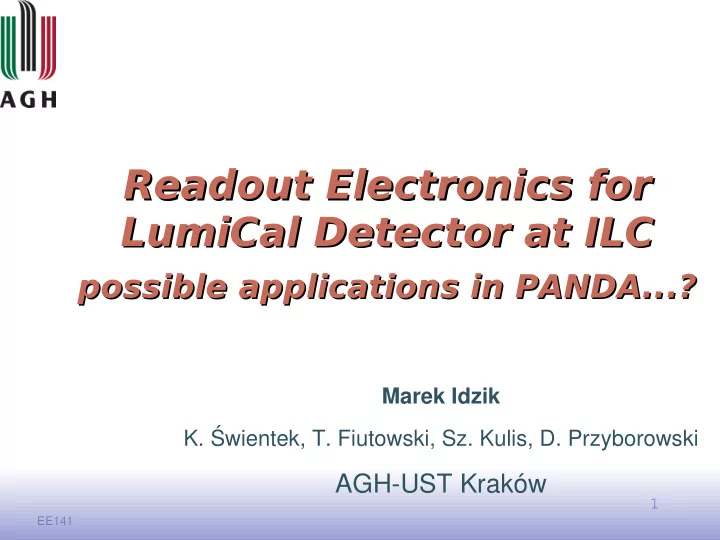

Readout Electronics for Readout Electronics for LumiCal Detector at ILC LumiCal Detector at ILC possible applications in PANDA...? possible applications in PANDA...? Marek Idzik K. Świentek, T. Fiutowski, Sz. Kulis, D. Przyborowski AGHUST Kraków 1 EE141
Outline Outline LumiCal Architecture and Readout LumiCal Frontend electronics ADC design and measurements General purpose DAC design Other designs Summary 2 EE141
LumiCal architecture LumiCal architecture Signal: from 2 fC 10 pC Si/W sandwich calorimeter, 2 half barrels, each 30 layers Occupancy: up to ~20% Sensors: C det 10100 pF leakage current ? Inter bunch time ~ 350 ns Low average power dissipation Each layer consists of 0.35cm thick tungsten and 300 µ m thick Si sensor Single detector layer 48 azimuthal sectors, 3 each sector ~96 radial pads EE141
LumiCal Readout System LumiCal Readout System 4 EE141
Front-end architecture Front-end architecture Components Charge amplifier Pole zero cancellation CR-RC Shaper Specifications (old): C det = 10 – 100 pF ● T peak ~ 60 ns ● Variable gain: physics and calibration mode ● Physics mode: Q max ~ 10 pC (C f =10 pF) ● 5 Calibration mode: S/N > 10 for MIP ● EE141
Front-end prototype Front-end prototype AMS 0.35 µ m technology 8 channels 4 channels with MOS feedback 4 channels with passive R f feedback Power dissipation < 9mW/channel 6 EE141
Pulse shape Pulse shape Very good charge sensitivity in Very good charge sensitivity in Slight sensor capacitance Slight sensor capacitance physics mode (same for MOS and physics mode (same for MOS and dependence in calibration dependence in calibration passive R f feedback) passive R f feedback) mode (gain for MOS and R f mode (gain for MOS and R f feedback different by design) feedback different by design) 7 EE141
Gain Gain Slight gain decrease with Slight gain decrease with Constant gain in physics mode Constant gain in physics mode growing sensor capacitance growing sensor capacitance in calibration mode in calibration mode 8 EE141
Noise Pulse rate Noise Pulse rate - Noise measurements done with external capacitance and - Noise measurements done with external capacitance and generator. Need to be confirmed with sensor and particles generator. Need to be confirmed with sensor and particles - In calibration mode noise < 0.4 fC - good MIP sensitivity (SNR > 10 SNR > 10) ) - In calibration mode noise < 0.4 fC - good MIP sensitivity ( - Front-end works well up to ~3 MHz continuous input rate - Front-end works well up to ~3 MHz continuous input rate 9 EE141
LumiCal front-end LumiCal front-end with straw tubes with straw tubes ASIC output connected to external ADC Connection between detector and preamplifier through RC decoupling filter First Measurements taken by P.Salabura and J. Smyrski Group at Jagiellonian University Systematic investigations and comparison with Carioca frontend in progress! 10 EE141
ADC architecture ADC architecture Pipeline architecture (fully differential) 10 bits resolution (1.5 bit per stage) Input dynamic range 2 V Maximum sampling rate 35 MHz Power efficient & small area 11 EE141
1.5 bit stage architecture 1.5 bit stage architecture Differential amplifier with boosted gain Dynamic latch comparators 12 EE141
ADC 2nd prototype ADC 2nd prototype AMS 0.35 µ m technology Channel area about 330 µ m x 2950 µ m All 9 stages and Sample&Hold Digital correction implemented Biasing and Reference voltages applied externally 13 EE141
ADC test setup ADC test setup (FPGA based) (FPGA based) Static measurements INL, DNL, ENOB Dynamic FFT measurements SNHR, THD, SFDR, SINAD, ENOB 14 EE141
ADC measurements ADC measurements Very preliminary! Very preliminary! Power consumption at 30MHz Analog 814mA x 3.3V Digital 6mA x 3.3V 15 EE141
Static ADC tests Static ADC tests Very preliminary! Very preliminary! Maximum Integral Nonlinearity INL < 1 LSB Maximum Differential Nonlinearity DNL < 0.6 LSB 16 EE141
Dynamic FFT ADC tests Dynamic FFT ADC tests Very preliminary! Very preliminary! Example of FFT spectra Good S/N (SNHR), resolution slightly worse than from static 17 measurements, but 3 rd harmonic might come from the setup EE141
General purpose DAC General purpose DAC DAC specifications: 10 bits Voltage output High swing Low power (<1mW) Small area No high rate request 18 EE141
I-steering 10 bit DAC design I-steering 10 bit DAC design 9 bit current DAC I-V converter with class Current AB output mirror amplifier 19 EE141
DAC measurements DAC measurements Transfer function 0.35 µ m CMOS Area 0.18mm 2 Power <0.6mW 20 EE141
Static measurements Static measurements INL measurements OK 21 DNL generally OK, for few points worse than 0.5 LSB EE141
Other designs in progress... Other designs in progress... Bandgap based reference voltage and thermometer circuits ready for submission Fast LVDS driver ready for submission Fast LVDS receiver ready for submission 22 EE141
Summary Summary Development of LumiCal Redout electronics in progress Frontend prototypes tested 10 bit ADC prototypes ready, first tests promising 10 bit DAC prototypes tested Other designs (Bandgap, LVDS) ready for submission Readout for PANDA straw tubes under study, real design work should start in the second part of 2009 If possible components of LumiCal readout will be used in PANDA 23 EE141
Recommend
More recommend